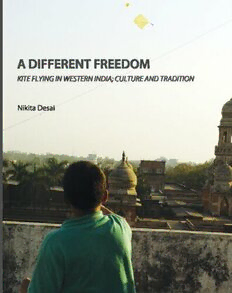
A Different Freedom: Kite Flying in Western India; Culture and Tradition PDF
Preview A Different Freedom: Kite Flying in Western India; Culture and Tradition
A Different Freedom A Different Freedom: Kite Flying in Western India; Culture and Tradition By Nikita Desai A Different Freedom: Kite Flying in Western India; Culture and Tradition, by Nikita Desai This book first published 2010 Cambridge Scholars Publishing 12 Back Chapman Street, Newcastle upon Tyne, NE6 2XX, UK British Library Cataloguing in Publication Data A catalogue record for this book is available from the British Library Copyright © 2010 by Nikita Desai All rights for this book reserved. No part of this book may be reproduced, stored in a retrieval system, or transmitted, in any form or by any means, electronic, mechanical, photocopying, recording or otherwise, without the prior permission of the copyright owner. ISBN (10): 1-4438-2273-6, ISBN (13): 978-1-4438-2273-2 CONTENTS Acknowledgements vii Preface ix The History of the Kite 1 The Lure of the Kite 11 Why Fly? 25 The Making of a Fighter 37 What is Manjha? 66 Firkis, Whistles and Other Accessories 89 From Dusk to Dawn 99 Looking Skyward 111 Fit for Kings 123 On Foreign Soil 133 A Tangle of the Mind 145 Notes 156 Bibliography 167 vviiii ACKNOWLEDGEMENTS In completing my researches for this book I owe the biggest debt of gratitude to the kite and manjha makers of Gujarat, people like Rajubhai Patangwala, Manowar Khan, Mustafabhai, Yasimbhai and many others who invited me to share their life and craft without asking for anything in return. I also would like to thank Mr. Bhanu Shah for sharing his knowledge and experiences with me and Mr. Vijaybhai Thakkar at the Kite Museum for allowing me to photograph and use the museum’s resources towards this publication. Thanks also to Mr. Ashim Samanta and Shakti Films for allowing me to reproduce the lyrics from ‘nah koi umang hai’, Kati Patang (1960) and to Bill Weir for the use of an excellent photograph of a ceiling painting in Shekhawati on page 26. Also many thanks to Mr. Srivastava and his family for their help and enthusiasm in recounting Lucknow’s kiting traditions. I owe a lot to Prof. Vishvajit Pandya, Prof . Madhumita Mazumdar, and Anirban Dutta Gupta for supporting my research as a student, and later on encouraging this book. Also many thanks to Brian and Eileen Coates and Dr. Micheal O’ hAodha for that first push and Cambridge Scholars Publishing for putting faith in me, especially Amanda for bearing with my almost daily mails and queries over the past months. To my friends and family, this couldn’t have been possible without your endurance, encouragement and willingness to visit kite and manjha markets and send in many of the stories I have put down here. Be it Gujarat, Bengal, Maharashtra, South India or the USA, its nice to know there are so many of you around to check up facts and keep flying kites… To each one of you, my warmest, and heartfelt thank you. viii iixx PREFACE My journey into the world of kites began at an early age. I must have been no older than seven or eight but I still cherish memories of flying a blue kite on blue manjha in suburban Bombay (It was yet to change its name to Mumbai). This was before the multinational companies (MNCs) and call centres occupied the urban landscape to drag my generation to work on ‘lesser holidays’ like Uttarayan. With a decline in interest in the festival, today many Gujaratis prefer to leave this mega city to return to hometowns across Gujarat to enjoy the pleasures of kite flying and Uttarayan. For me a move to Vadodara meant that every Uttarayan has been noisier than the last. Here the day still begins with the blast of music from the terrace of our apartment. The kite battles can never begin soon enough for some and 9 a.m. is considered a late start to the day. Never fond of getting cut with the lethal manjha1, I have always preferred to handle the firki or spool of kite line…a typical sahel lena2, who is content to let others do the actual flying. As my friends tugged at their kite lines, manoeuvring their kites into tangles, I would often sit in the relative comfort of a shady wall, spool in hand, watching the battles unfold in the sky above. Even today, I spend the festival watching the kites soar through the sky, and occasionally, just occasionally, taking on the actual flying and winning of a tangle. Some things never change!! I began researching the cultures of kite fighting in my senior year as a post- graduate student of design. As my project on visual culture progressed, I fell in love with the kite once more. No longer just a spool handler who came to the terrace to enjoy the thumpa thump of the gigantic speakers, I was transformed now into a camera wielding tourist in my own backyard!! In the past I had attended kinnah (kite bridle) tying parties and rooftop dances but for the first time I now set foot into the midnight kite markets I had heard so much about. The aim of my project at that time was to highlight not just the festival and its celebrations in the state, but also the pace and preparations that take place in the run up to this day. My researches lead me to find many a reference in books, websites, newspapers and kiting magazines. The Ahmedabad Kite Museum, and its founder and ex-curator Mr. Bhanu Shah gave me valuable insights into kiting history, and interacting with participants at the International Kite Festival
